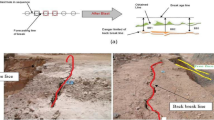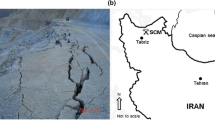Abstract
Backbreak is one of the destructive side effects of the blasting operation. Reducing of this event is very important for economic of a mining project. Involvement of various parameters has made the backbreak analyzing difficult. Currently there is no any specific method to predict or control the phenomenon considering all the effective parameters. In this paper, artificial neural network (ANN) as a powerful tool for solving such complicated problems is used to predict backbreak in blasting operation of the Sangan iron mine, Iran. Network training was fulfilled using a collected database of the practiced operation including blast design details and rock condition. Trying various types of the networks, a network with two hidden layers was found to be optimum. Performance of the ANN model was compared with statistical analysis using datasets which were kept apart from the original database. According to the obtained results, for the ANN model there existed a higher correlation (R2 = 0.868) and lesser error (RMSE = 0.495) between the predicted and measured backbreak as compared to the regression model. Also, sensitivity analysis revealed that the inputs rock factor and number of rows are the most and the least sensitive parameters on the output backbreak, respectively.






Similar content being viewed by others
References
Ambromi TW, Turk G (2003) Prediction of subsidence due to underground mining by artificial neural networks. Comput Geosci 29:627–637
Babuˇska R (2004) Fuzzy and neural control. Delft University of Technology, DISC Course Lecture Notes, Netherlands
Bhandari S, Rathore SS (1997) Engineering rock blasting operations, A.A Balkema, Rotterdam
Brent GF, Smith GE (2000) The detection of blast damage by borehole pressure measurement. J S Afr Inst Min Metall 100(1):17–22
Chain R, Talhi K (2005) Design of model blasting for evaluating bench slope stability. Asian J Inf Technol 4:1170–1176
Demuth, H., Beale, M. (2008). Neural network toolbox: for use with MATLAB. User’s Guide, Version 4, The MathWorks Inc
Ding D, Zhang Z (2004) Artificial neural network based inverse design method for circular sliding slopes. J Central South University Technol 11:89–92
Dreyfus G (2004) Neural networks: methodology and applications, 2nd edn. Published by Eyrolles, Paris
Dyno Nobel group (1998) Dyno Nobel user manual and technical data sheets. (1st ed.). Sweden, Gyttorp
Eskandari H, Rezaee MR, Mohammadnia M (2004) Application of multiple regression and artificial neural network techniques to predict shear wave velocity from wireline log data for a carbonate reservoir South-West Iran. CSEG Recorder 42:48
Etkin MB, Azarkovich AE, Sapronov AA, Vartanov VG (2001) Protecting external rock bodies from blasting damage. Power Technol Eng 35:499–506
Forsyth WW, Moss AE (1991) Investigation of development blasting practices. CANMET-MRL, 91–143
Gates WCB, Ortiz LT, Florez RM (2005) Analysis of rockfall and blasting backbreak problems. The 40th U.S. Symposium on Rock Mechanics (USRMS), Alaska, 25-29
Giraudi A, Cardu M, Kecojevic V (2009) An assessment of blasting vibrations: a case study on quarry operatio. Am J Environ Sci 5:467–473
Gokceoglu C, Zorlu K (2004) A fuzzy model to predict the uniaxial compressive strength and the modulus of elasticity of a problematic rock. Eng Appl Artif Intell 17:61–72
Grima MA (2000) Neuro-fuzzy modeling in engineering geology. A.A. Balkema, Rotterdam
Hayakin S (1998) Neural networks: a comprehensive foundation, 2nd edn. Prentice Hall, Englewood Cliffs
Hoek E, Bray J (2004) Rock Slope Engineering, Civil and Mining. (4th ed). In: C. Duncan
Hustrulid W (1999) Blasting principles for open pit mining, vol 1. Balkema, A.A
Jennrich RI (1995) An introduction to computational statistics-regression analysis. N.J. Prentice-Hall, Englewood Cliffs
Jhanwar JC, Jethwa JL (2000) The use of air-decks in production blasting in an open pit coal mine. Geotech Geol Eng 18:269–287
Jong YH, Lee CI (2004) Influence of geological conditions on the powder factor for tunnel blasting. Int J Rock Mech Min Sci 41:533–538
Kahraman S, Gunaydin O, Alber M, Fener M (2009) Evaluating the strength and deformability properties of Misis fault breccia using artificial neural network. Expert Syst Appl 36:6874–6878
Khandelwal M, Singh TN (2006) Prediction of blast induced ground vibrations and frequency in opencast mine: a neural network approach. J Sound Vib 289:711–725
Khandelwal M, Singh TN (2009) Prediction of blast-induced ground vibration using artificial neural network. Int J Rock Mech Min Sci 46:1214–1222
Kojovic T (2005) Influence of aggregate stemming in blasting on sag mill performance. Mineral Eng 18:1398–1404
Konya CJ (2003) Rock blasting and overbreak control. (2nd ed). US Department of Transportation, National Highway Institute
Konya CJ, Walter EJ (1991) Rock blasting and overbreak control. (1st ed). US Department of Transportation, National Highway Institute
Kuzu C, Ergin H (2005) An assessment of environmental impacts of quarry-blasting operation; A case study in Istanbul, Turkey. Environ Geol 48:211–217
Langefors U, Kihlström B (1978) The modern technique of rock blasting, 3rd edn. John Wiley, New York
Latham JP, Ping Lu (1999) Development of an assessment system for the blastability of rock masses. Int J Rock Mech Min Sci 36:41–55
Lopez JC, Lopez JE (1995) Drilling and blasting of rocks. A.A Balkema, Rotterdam
Lyall W, Eloranta J (2010) The effects of blasting on crushing and grinding efficiency and energy consumption. Online e-book at: http://www.elorantaassoc.com/Blasteffects_Lyall.pdf
MacKenzie AS (1967) Optimum blasting. Proceedings of the 28th Annual Minnesota Mining Symposium, p 181-188
Maity D, Saha A (2004) Damage assessment in structure from changes in static parameters using neural networks. Sadhana 29:315–327
Mandal SK, Singh MM, Dasgupta S (2008) Theoretical concept to understand plan and design smooth blasting pattern. Geotech Geol Eng 26:399–416
Meulenkamp F, Grima AM (1999) Application of neural networks for the prediction of the unconfined compressive strength (UCS) from Equotip hardness. Int J Rock Mech Min Sci 36:29–39
Monjezi M, Dehghani H (2008) Evaluation of effect of blasting pattern parameters on back break using neural networks. Int J Rock Mech Min Sci 45(8):1446–1453
Monjezi M, Yazdian A, Hesami SM (2006) Use of back propagation neural network to estimate burden in tunnel blasting. India. Mines Metals and Fuels 54:424–429
Monjezi M, Rezaei M, Yazdian A (2010) Prediction of backbreak in open-pit blasting using fuzzy set theory. Expert Syst Appl 37:2637–2643
Monjezi M, Khoshalan HA, Varjani AY (2012) Prediction of flyrock and backbreak in open pit blasting operation: a neuro-genetic approach. Arab J Geosci 5(3):441–448
Murthy VMSR, Dey K, Raitani R (2003) Prediction of overbreak in underground tunnel blasting a case study. J Can Tunn 109-115
Musil M, Plesinger A (1996) Discrimination between local micro earthquakes and quarry blasts by multi-layer perceptrons and Kohonen maps. Bull Seismol Soc Am 86(4):1077–1090
Nilson K, Kristiansen J (1996) Blasting, crushing, grinding: Optimization of an integrated comminution system. Rock Fragmentation by Blasting, FragBlast5, Rotterdam, Balkema, 269-283
Oliver PH (2003) Changes to drill pattern and adequate inter-row delay time improve blasting performance. CIM Bulletin, Proquest Science Journals
ÖzgenKaracan C (2007) Development and application of reservoir models and artificial neural networks for optimizing ventilation air requirements in development mining of coal seams. Int J Coal Geol 72:221–239
Pompanna YV, Chikkareddy FV (1993) Improving blasting performance by air-decking; An Expriment. India, Proceeding of Drill and Blast, 63
Rafiq MY, Bugmann G, Easterbrook DJ (2001) Neural network design for engineering applications. Comput Struct 79:1541–1552
Rowlands DM (1989) Separating explosive charges with air gaps to improve fragmentation whilst reducing explosive usage. Proceeding of Second Large Open Pit Mining Conference, 105
Sebastia M, Olmo IF, Irabien A (2003) Neural network prediction of unconfined compressive strength of coal fly ash–cement mixtures. Cem Concr Res 33:1137–1146
Singh TN, Singh V (2005) An intelligent approach to prediction and control ground vibration in mines. Geotech Geol Eng 23:249–262
Stegemanna JA, Buenfeld NR (2003) Prediction of unconfined compressive strength of cement paste containing industrial wastes. Waste Manage 23:321–332
Stephen H, Chung, Graham, Mustoe GW (2007) Effects of particles shape and size distribution on stemming performance in blasting, Discrete Element Methods. Numerical Modeling of Discontinua Proceedings of the Third International Conference on Discrete Element Methods, 288–293
TantaviMohammad M (2009) Artificial neural network for prediction and control of blasting vibrations in Assiut (Egypt) limestone quarry. Int J Rock Mech Min Sci 46:426–431
Tawadrous AS (2006) Evaluation of artificial neural networks as a reliable tool in blast design. Int Soc Explos Eng 1:1–12
Thote NR, Singh DP (2000) Effect of air decking on fragmentation: a few case studies of Indian mining. Explosive and Blasting Techniques, Rotterdam
Tiryaki B (2008) Application of artificial neural networks for predicting the cutability of rocks by drag tools. Tunn Undergr Sp Technol 23:273–280
Tsekouras GJ, Koukoulis J, Mastorakis NE (2010) An optimized neural network for predicting settlements during tunneling excavation. WSEAS Trans Sys 9(12):1153–1167
Yong He, Sixin Xu, Kejun Z, Ting L, Yue Li (2008) A genetic-neural method of optimizing cut-off grade and grade of crude ore. Lect Notes Comput Sci 5264:588–597
Author information
Authors and Affiliations
Corresponding author
Rights and permissions
About this article
Cite this article
Monjezi, M., Hashemi Rizi, S.M., Majd, V.J. et al. Artificial Neural Network as a Tool for Backbreak Prediction. Geotech Geol Eng 32, 21–30 (2014). https://doi.org/10.1007/s10706-013-9686-7
Received:
Accepted:
Published:
Issue Date:
DOI: https://doi.org/10.1007/s10706-013-9686-7




